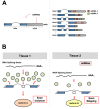miRNA-Based Regulation of Alternative RNA Splicing in Metazoans
- PMID: 34769047
- PMCID: PMC8584187
- DOI: 10.3390/ijms222111618
miRNA-Based Regulation of Alternative RNA Splicing in Metazoans
Abstract
Alternative RNA splicing is an important regulatory process used by genes to increase their diversity. This process is mainly executed by specific classes of RNA binding proteins that act in a dosage-dependent manner to include or exclude selected exons in the final transcripts. While these processes are tightly regulated in cells and tissues, little is known on how the dosage of these factors is achieved and maintained. Several recent studies have suggested that alternative RNA splicing may be in part modulated by microRNAs (miRNAs), which are short, non-coding RNAs (~22 nt in length) that inhibit translation of specific mRNA transcripts. As evidenced in tissues and in diseases, such as cancer and neurological disorders, the dysregulation of miRNA pathways disrupts downstream alternative RNA splicing events by altering the dosage of splicing factors involved in RNA splicing. This attractive model suggests that miRNAs can not only influence the dosage of gene expression at the post-transcriptional level but also indirectly interfere in pre-mRNA splicing at the co-transcriptional level. The purpose of this review is to compile and analyze recent studies on miRNAs modulating alternative RNA splicing factors, and how these events contribute to transcript rearrangements in tissue development and disease.
Keywords: C. elegans; CELF; PTBP1; PTBP2; Quaking; RBFOX; SR proteins; alternative splicing; cancer; hnRNPs; microRNA; tissue differentiation.
Conflict of interest statement
The authors declare no conflict of interest.
Figures


References
Publication types
MeSH terms
Substances
Grants and funding
LinkOut - more resources
Full Text Sources
Research Materials

